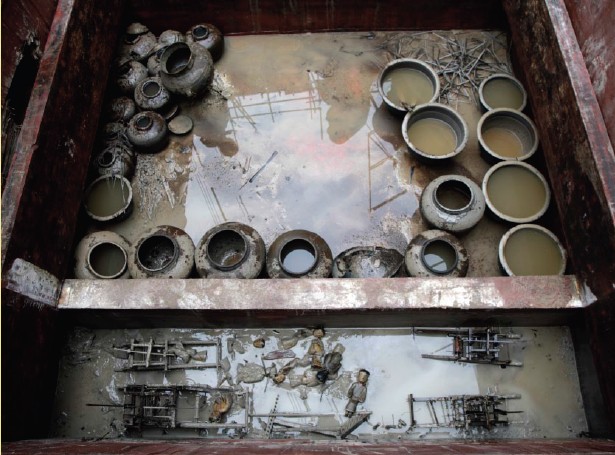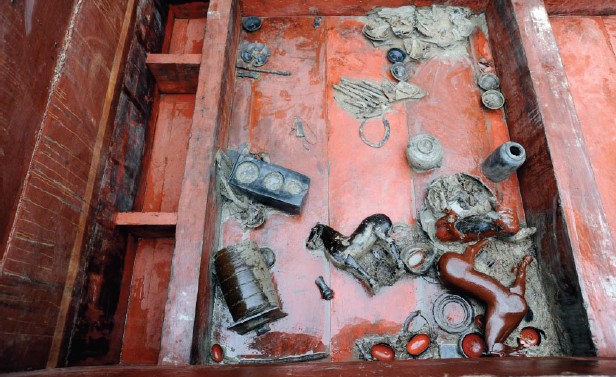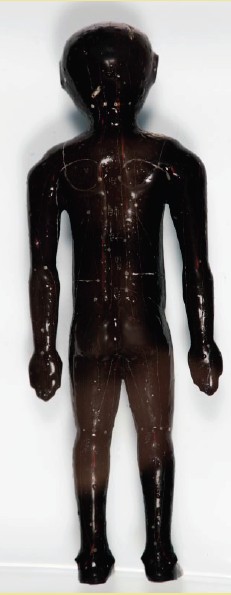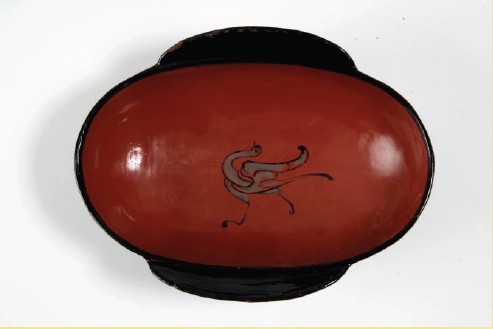Medical Wood and Bamboo Slips found in Han Dynasty Tombs in Chengdu, SW China
From:Chinese Archaeology NetWriter:Date:2014-04-11
Salvage excavation of Western Han Dynasty tombs has been carried out by Chengdu Institute of Archaeology and Jingzhou Cultural Relics Preservation Center in Tianhui Town, Jinniu Area, Chengdu city during July 2012 and August 2013. Four tombs have been cleared. Various of precious artifacts are unearthed including lots of lacquerwares, pottery wares as well as some copper, jade, iron ones and so on. Among all the discoveries, the wood slips from tomb M1, bamboo slips and lacquer human figurine painted with channel and acupoints from tomb M3 as well as the wood and bamboo models of waving machine found in tomb M2 are of special importance.
The place where the tombs locate is named “Laoguanshan” by local people. Four tombs spread on the two sides of Rongdu Avenue from south to north. On the northern end, M2 and M3 are under the same mound. They might belong to the same group of tombs. While M1 and M4 are about 30 and 420 meter southern of M2 and M3 respectively and all looted in earlier time.

details of North Secret Box in tomb M2
The tombs are all earthen shaft pit tombs with a wooden outer coffin. They are of more or less the same size and in north-south direction. The heavily-destroyed mounds of the tombs are rammed layer by layer. M1 and M3 have passages and are in the shape of the Chinese character “凸”。The rest two are rectangular in plane without passages. The outer coffins are about 5-7m long, 3-4.5m wide and 2-2.2m deep. Except M1, the bottoms of the outer coffins in other tombs all have secret boxes which are divided into several parts. Each area contains one kind of funeral gifts. The inner walls of outer coffins are painted red while the outside are filled by green paste mud. Some of them, like M2, are covered by coir mattresses. The size of tenon-and-mortise joint coffin boards is about 0.6m wide and o.3m thick. One or two inner wooden coffins are inside each outer coffin. The inside walls of inner coffins are painted black, whereas the outside walls are black or red. Most of the outside walls are decorated by copper button-shaped ornament and wood bi-disks. Silk is found on the coffins of M2, which might be silk cover.

details of Sorth Secret Box in tomb M2
Burial gifts are discovered in the bottom of outer coffins and their secret boxes. The artifacts from the bottom of outer coffins are often looted severely, while ones found in the secret boxes are well-preserved and nearly intact. More than 620 artifacts have been unearthed excluding wood and bamboo slips. Among them, there are about 130 pottery wares including guan-jars, ding-tripods, pen-vessels, bo-bowls, weng-jars, hu-pots as well as models of well and hearth and so on. More than 240 lacquerwares are cleared ranging from cups, dressing boxes, tables, dishes, he-vessels, human and horse figurines and etc. Some of them have exquisite decorative patterns of clouds, dragons, birds, character symbol and etc. There are various kinds of human figurines. The clothing on them are two different kinds, shen yi (typical Han Dynasty clothing) and duan he (relatively coarse clothing). Some of the figurines are adorned by colored paintings as well as Chinese characters. Besides, there are 140 wooden wares, which are bi-disks, canes, holders, table, hemispherical vessels, models of house and weaving machine and the like. What’s more, 100 copper artifacts (including coins) are found, ranging from crossbows, belt hooks, buckles, Banliang and Wuzhu coins and the like. One jade seal is unearthed in M2, as well as some iron artifacts, bamboo-weaving wares, straw or mat artifacts and so on.

weaving machines unearthed In the northern secret box in M2
According to initial statistics, more than 50 wood slips are cleared in M1 and 920 bamboo slips found in M3. The majority of the strips is preserved completely and can be recognized and separated into different books. From preliminary study, the wood slips in M1 are government papers and witchcraft records. The former ones involve laws on payment of adult poll tax and stabilization of commodity price and so on. The serial numberd of bamboo slips in M3 are No.121 and No.137. No. 121 concludes 736 slips (including broken ones), which can be divided into nine ancient medical books involving BiXi ( Bian Que ) YiLun ( Medical Study by BiXi (Bian Que) ), WuSe MaiZang Lun( Study on five color pulse and organs) and etc. The contents cover meridian, pharmacy, medical prescriptions, pathology and the so on.

The lacquer human figurine with white and red paintings of channel and acupoints found in tomb M3
The lacquer human figurine with exact facial features and limbs found in M3 are almost 14cm high. White and red paintings of channel and acupoints marked on the figurine are clearly visible. Different parts of the body carve Chinese characters of “心” (heart),”肺” (lungs) and etc.
In the northern part of secret box in M2, four weaving machines with complex structures are discovered. They are all made of wood and bamboo. Silk lines and pigments still remain on some parts of the machines. One of them is relatively large, about 50cm high, 70cm long and 20cm wide. The rest three are smaller and of more or less the same size, roughly 45cm high, 60cm long and 15cm wide. Four looms should be models with different functions in terms of their different structures. More than 10 painted wood figurines are found near the machines. They might be weavers according to their postures and inscriptions.

lacquer cup unearthed from tomb M2
M1 has Wuzhu coins in Emperor Wu Period of Han dynasty. The rest tombs only have Banliang coins dating back to Western Han dynasty. The design of the secret boxes in the bottom of outer coffins is similar to the wood outer coffin tombs in Xindu majia site from the late Warring states period. In this case, they may be earlier than M1. Besides, funeral customs and graving goods are close to the wooden outer coffin tombs in Fenghuangshan, Chengdu. The assemblage of well, hearth and granary models is also unearthed in these three tombs. All in all, they may belong to Emperor Jing and Wu periods of Han dynasty.
Plenty of bamboo and wood slips from Western Han Dynasty unearthed in Han dynasty tombs in Laoguanshan are firstly discovered in Sichuan area. This makes Chengdu another important place where Han Dynasty slips are found. The long-lost medical slips of classic books of Bian Que medical school are important chapters in Chinese medical history. The lacquer human figurine is the earliest and most complete human figurine with channel and acupoints ever found in China so far. It, together with the meridian books uncovered in the tombs, plays an important role on the origin and development of traditional medical meridian and acupuncture theories. The four weaving machines are regarded as models of Shu state brocatelle jacquard machines which have never been seen before. As the only complete examples of Han Dynasty looms with original unearthed unit, they fill in gap of world textile history and of significant importance of the study on the origin and development of silk weaving technique at home and abroad. Lots of lacquerwares found in the tombs prove once again that Chengdu is an important center of lacquer work production in Qin and Han Dynasties. (Translator: Ma Huanhuan)

